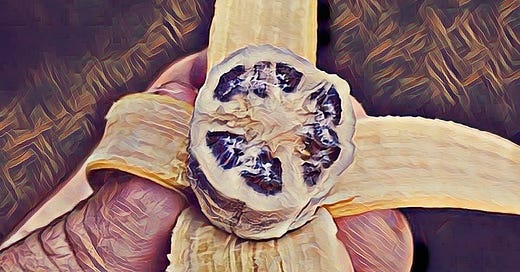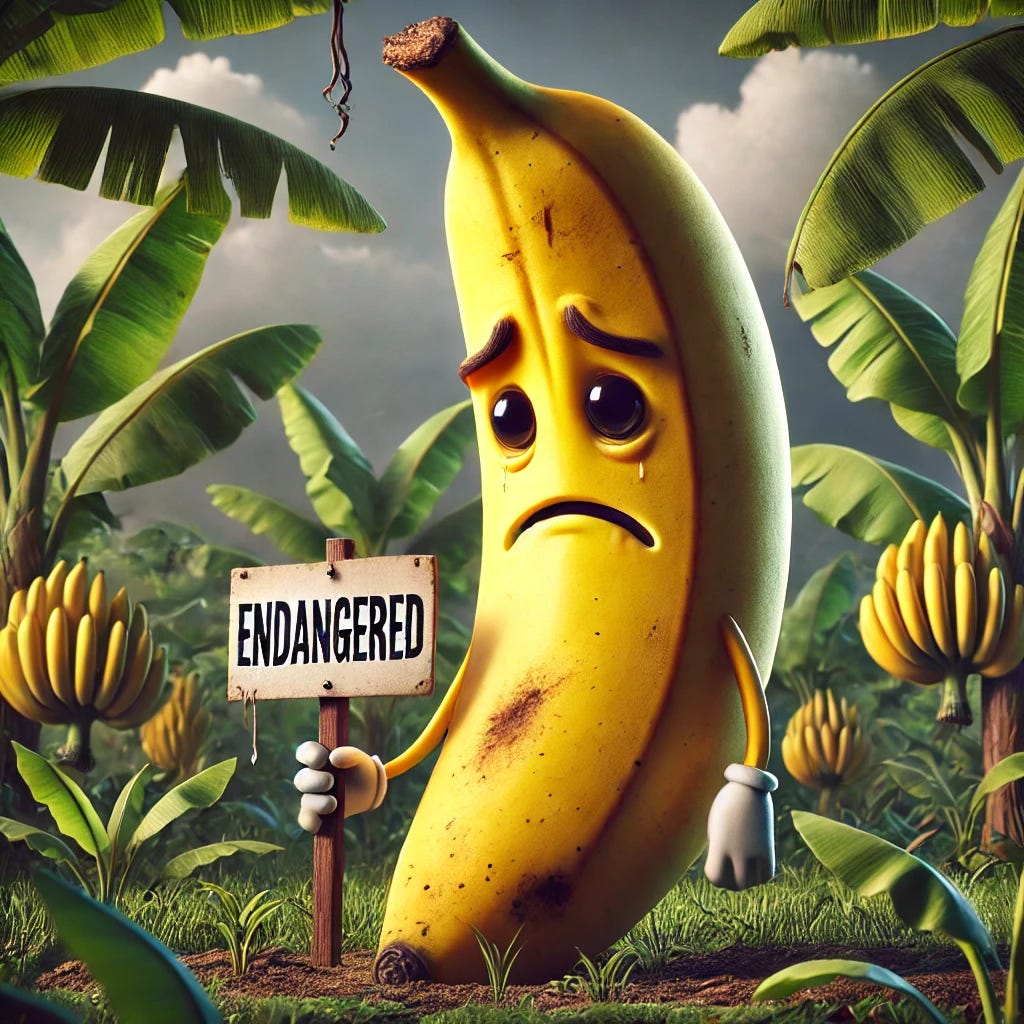This is what an untampered with banana should look like, which would be quite difficult to eat. As a child, I grew up in England and bananas were so typical, as a fruit and I had no idea that bananas were not grown in England. Now in 2024 this is pretty much worldwide. “According to the Food and Agriculture Organization (FAO) of the United Nations, global banana production reached approximately 119 million metric tons in 2021. Most of these bananas are consumed domestically in the countries where they are grown, with a smaller percentage being traded internationally.” Just to repeat, outside of Kew Gardens, bananas do not grow in any quantity in England, nor in any country in Northern Europe. This is not the main point of this post, this is “The bananas we see in the supermarket are a cultivar called the Cavendish banana. They're the classic banana shape that we recognize, long, golden-yellow, and curved. 55 million tons of Cavendish bananas are grown a year worldwide. This variety is descended from a banana first grown in a hothouse in northern England in the 1800s. Who would have guessed the rainy origins of such an exotic fruit?” This is from an article published by Kew Gardens, of all people and England pops up again.
However, the Cavendish banana is under imminent threat, lets look at why, with some history of edible bananas and particularly Cavendish. Growing human-edible bananas (such as the common Cavendish variety) from seeds is practically impossible in most cases. This is because edible bananas are typically sterile hybrids, meaning they do not produce viable seeds capable of germinating into new plants. Instead, commercial and home-grown bananas are propagated using cuttings or suckers (pups), which are shoots that grow from the base of the banana plant. We view this as a highly risky strategy, the true core root (pun intended) of almost all land-based plants-fungi are either seeds or spores. Let’s dig into this a little more.
Here's a more detailed breakdown of the difficulties involved:
1. Seed Viability: The seeds of edible bananas are usually underdeveloped due to their hybrid nature. Most banana seeds will not germinate even if planted, as they aren't viable.
2. Types of Bananas: Wild bananas, which are the ancestors of modern edible bananas, do have seeds and can be grown from them. However, these bananas contain hard seeds throughout the fruit, and the flesh is less palatable (see our first image above) . Growing wild bananas from seeds is possible but requires much patience and specialized care.
3. Propagation from Cuttings: This is the standard method for growing edible bananas. By taking a sucker or rhizome (the underground stem), you can produce an identical clone of the parent plant. This method is far more practical, reliable, and faster than attempting to grow from seeds.
4. Time and Effort: Even if you could find viable seeds for edible bananas, they would take much longer to mature compared to propagation through cuttings. Seeds might take several weeks or months to germinate under controlled conditions, whereas suckers will establish themselves much faster.
In summary, the current commerce driven imperatives state or believe that growing edible bananas from seeds is not practical due to the sterility of the seeds. Our viewpoint is why are these seeds sterile in the first place, (see the following section)? Propagation from cuttings is the most reliable and widely used method. Once again, cuttings only exist because a plant grew in the first place and we need seeds to ensure the ongoing survival of this plant species.
Banana seeds became sterile largely due to the domestication and selective breeding process. The sterility of modern edible bananas is a result of their hybridization, which involved crossbreeding two wild species of bananas: Musa acuminata and Musa balbisiana.
Here's how it happened:
1. Wild Bananas with Seeds: The original wild bananas, both Musa acuminata and Musa balbisiana, produced fruit with large, hard seeds. However, these wild bananas also had small amounts of edible flesh and were not very pleasant to eat because the seeds occupied much of the fruit. (see our first image above as a possible illustration of this).
2. Hybridization: Early human cultivators discovered that some banana plants produced fruit with fewer seeds and more flesh. These bananas were the result of natural mutations and crossbreeding between the two species (Musa acuminata and Musa balbisiana). The resulting hybrids had a more edible flesh-to-seed ratio.
3. Sterility through Triploidy: The hybrid bananas that we eat today, such as the Cavendish, are triploid, meaning they have three sets of chromosomes instead of the usual two. This abnormal chromosome count results in sterility because the uneven number of chromosomes cannot properly divide during the formation of seeds. As a result, these triploid bananas don't produce viable seeds, and their fruit develops without seeds.
4. Selective Breeding: Over generations, humans selected and propagated plants with the best fruit characteristics (less seedy, more fleshy, and sweeter). These selections inadvertently favored sterile bananas, as they had fewer seeds, making them more palatable.
In essence, modern edible bananas became sterile due to human intervention—specifically, the process of selecting and cultivating hybrid plants with desirable traits. The trade-off for more edible flesh and better taste was sterility, which is why we now propagate bananas through cuttings rather than seeds.
Here is the cautionary tale, there was another banana which preceded the Cavendish as the effective monoculture banana, The Gros Michel, before the Cavendish banana became the dominant monoculture variety, the most widely eaten banana was the Gros Michel (also known as "Big Mike"). The Gros Michel was the primary banana variety exported to global markets from the late 19th century until the mid-20th century. It was known for its rich flavor, larger size, and thicker skin, which made it ideal for shipping and commercial trade.
What Happened to the Gros Michel?
The downfall of the Gros Michel was caused by a disease known as Panama disease, specifically the strain Tropical Race 1 (TR1) of the fungus *Fusarium oxysporum*. This soil-borne fungus attacks the roots of banana plants, causing them to wilt and die.
- Widespread Destruction: Panama disease began spreading in the early 20th century, devastating banana plantations in Central America, the Caribbean, and other regions where Gros Michel was grown. Because bananas are propagated through cuttings, all Gros Michel plants were genetically identical (clones), making them particularly vulnerable to disease. There was no genetic variation to help some plants resist the fungus. This is a really critical point!
- Eventual Replacement: By the 1950s, the disease had wiped out nearly all commercial Gros Michel plantations, forcing producers to find a replacement. The Cavendish banana was chosen because it was resistant to the TR1 strain of Panama disease, even though it was considered less flavorful than the Gros Michel. The Cavendish variety gradually became the dominant banana in global trade, replacing the Gros Michel by the 1960s.
Unfortunately, a new strain of Panama disease, called Tropical Race 4 (TR4), now threatens the Cavendish banana. Like the Gros Michel, the Cavendish is also genetically uniform, making it vulnerable to this disease. Efforts are underway to develop resistant varieties, but the future of commercial banana cultivation remains uncertain.
Oh yes and seedless produce/fruit/green groceries; that is our next main subject; please stay tuned.







